Ladies Fashions: Huge Sleeves of the 1890s
Ladies Fashions: Huge Sleeves of the 1890s
.
Before we dig in to the truth and (frankly, frightening) history of gigantic sleeves, let’s poke a wee bit of fun at the idea of making our female shoulders appear twice as wide as our male escort’s. After all, doesn’t EVERY woman want her dainty shoulders to appear broad enough, and sturdy enough, to carry the weight of the world? Didn’t our great-great-grandmothers want to appear twice as brawny as their beaus?
.
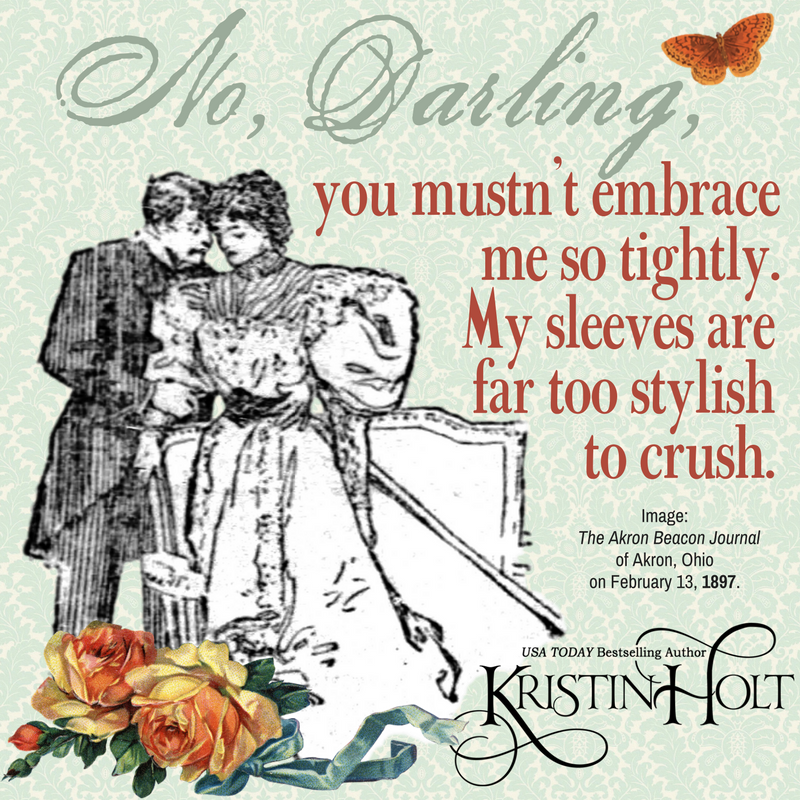
The vintage image, at the center-left of this image, was published (in a serious fictional tale serial about romance) in The Akron Beacon Journal of Akron, Ohio on February 13, 1897. I made up the “don’t squish my sleeves” line.
.
Worse, can you even imagine ironing those sleeves?
.
REALLY? THOSE SLEEVES WERE IN FASHION?
.

.
ABSOLUTELY!
.
If The House of Worth designed expensive gowns for New York’s elite, many of which have survived to be on display at The Met, we can absolutely agree the fashion was legitimate.
.

House of Worth Designer Charles Frederick Worth, 1893-1895. The Met, image courtesy of Pinterest.
.

1896 Fashion Plate No. 80. Image: Pinterest.
.

Shirt Waists, with Leg Of Mutton Sleeves in Haprer’s Bazaar (shown here in a collective from 1867-1898).
.
Middle- and upper-class women enjoyed fine fashion in the late 1890s (much earlier, too; see more House of Worth details, below). The poorest classes may not have been able to meet the barest of essentials (the nineteenth century was a very different time as far as social services and assistance), so the only groups missing the “Big Sleeve” era would’ve been “The Other Half“.
.

“Lodgers in a Crowded Bayard Street Tenement–5 cents a spot”, photograph by Jacob Riis, 1888, published in 1890 within HOW THE OTHER HALF LIVES. Image: Wikipedia, Public Domain.
.
But… Working Women–or at least middle-class women’s “work dresses” sported stylish sleeves too.
.
Woman’s workday dress (perhaps blouse and skirt), suited to all the homemaker’s daily chores, giving in to fashion’s demands for enormous sleeves. Published in The Akron Beacon Journal of Akron, Ohio on February 13, 1897. See the kitchen worktable, the broom handle, the mid-century plank door, knob, and locking bolt. This isn’t a woman who can afford a fully-staffed house, the leisure of greeting visitors in the parlor in her fancy day dress. This lady bakes her own bread, sweeps her own floors, and cleans her own wallpaper… if she has any.
.
Ladies Fashion: BRIDAL
.

Wedding Dress with enormous Leg Of Mutton Sleeves, illustrated in The San Francisco Chronicle of San Francisco, California on September 8, 1895.
.
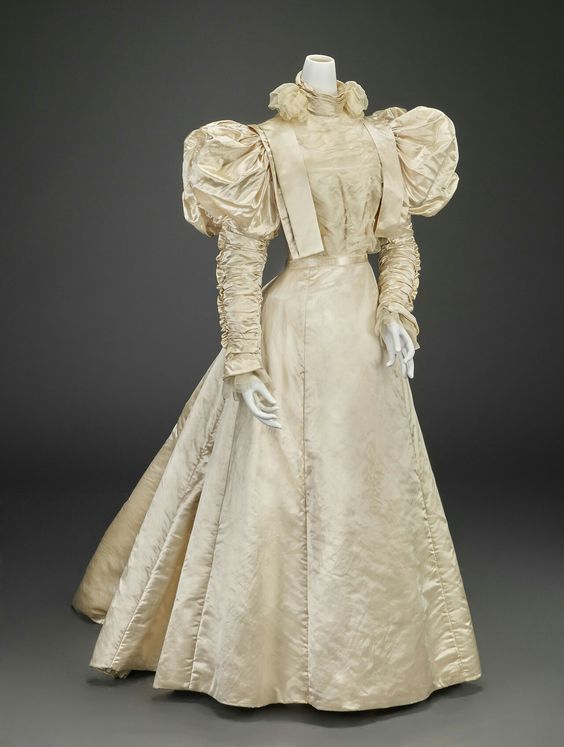
Wedding Dress: 1896. Image: Pinterest.
.

1890s Dresses, documented by Wikimedia. Public Domain Image.
.
DID REAL PEOPLE WEAR THIS STUFF–enormous sleeves?
.
Yes!
.

Man and woman, probably husband and wife (because of the traditional standing-and-seating arrangement), creditor to the 1890s. Image: Pinterest.
.
.

Gandee Rubbers Boots Advertisement (so perhaps this woman, a paid model, might not have selected the balloon sleeve style…? Notice she uses a button hook. Image: Pinterest.
.

“Puff Sleeves, 1890s“. Photo by Jan Langshans. Saved from flicker to Pinterest.
.

“Margaret”, photographed by Morrison photography, at Haymarket Theatre, Chicago. Credited by Pinterest pinner to 1890s.
.
WHEN did Ladies Fashion decide to love huge sleeves?
.
1893 to 1900, more or less… and well beyond
.

The “1900 Sleeve”, according to Wikipedia. Image shared on Pinterest by a pinner.
.
The leg of mutton sleeve (also known in French as the gigot sleeve) was initially named due to its unusual shape: formed from a voluminous gathering of fabric at the upper arm that tapers to a tight fit from the elbow to the wrist. First seen in fashionable dress in the 1820s, the sleeve became popular between approximately 1825 and 1833 – but by the time Queen Victoria ascended to the throne in 1837, the overblown sleeves had completely disappeared in favour of a more subdued style.
The trend returned in the 1890s, sleeves growing in size “much to the ridicule of the media” until 1906 when the mode once again changed. This distinct upper body silhouette has inspired designers at numerous points throughout the twentieth century and the Spring/Summer 2016 collections have seen a determined reappearance of the sleeve shape, with designers such as J.W. Anderson using the historical pattern to craft a contemporary silhouette. (emphasis added)
.
.
An Example of “Ridicule of the Media” ~
.
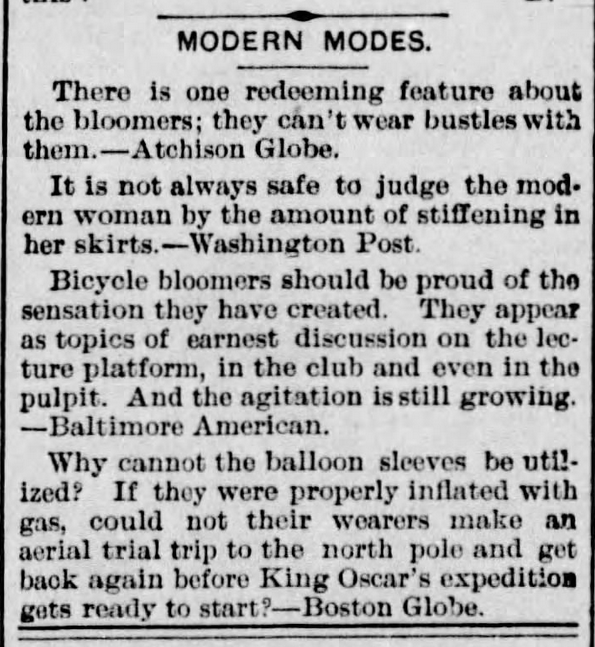
See? Leg Of Mutton sleeves were, indeed, referred to as “Balloon Sleeves” back in the day. See the media poking fun at fashions of the mid 1890s— bloomers, bustles, stiffening in skirts, bicycle bloomers–and in the final paragraph–BALLOON SLEEVES. Rather humorous, I think.
Originally published in Green Bay Press Gazette of Green Bay, Wisconsin on July 7, 1895.
.
HUGE SLEEVES REIGN: SUMMER AND WINTER, SPRING AND FALL
.

Summer Polka-dot Dress, 1890s. Image: Pinterest.
.

In February, fashion designers make a “Suggestion for a Summer Frock”. Originally published in The Times of Philadelphia on February 24, 1894.
.

New Walking Suits, advertised in The Sun and the Erie County Independent of Hamburg, New York on April 6, 1894.
.
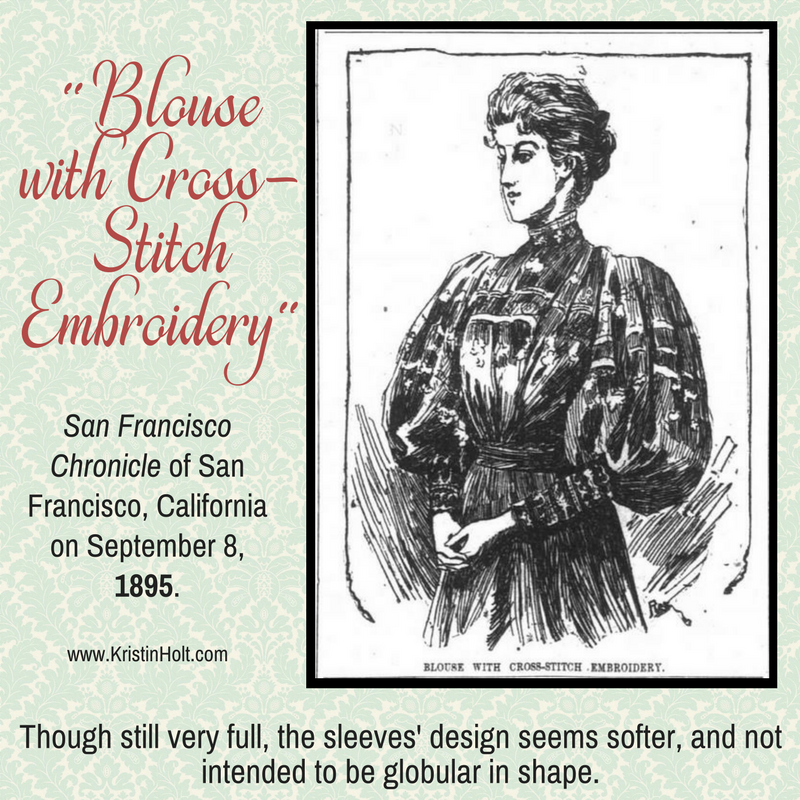
“Blouse with Cross-Stitch Embroidery”, though still very full, the sleeves’ design seems softer, and not intended to be globular in shape. Advertised in San Francisco Chronicle of San Francisco, California on September 8, 1895.
.

The Oshkosh Northwestern of Oshkosh, Wisconsin on March 28, 1896, displays fashions of the day.
.
WHAT on earth did Ladies Fashion call these huge sleeves?
.
“Big Sleeves”? “Balloon Sleeves”? “Puffy Sleeves”? “Marquise Sleeves”? Leg O’ Mutton? “Leg Of Mutton” Sleeves? “Gigot Sleeves”? “Chatelaine Sleeves?”
.

“The new Marquise Sleeve“, advertised in The Nebraska State Journal of Lincoln, Nebraska on June 11, 1895.
.

.

Did the wild sleeve design have anything to do with late Victorians’ fascination with hot air balloons?
.

Aeronaut: A traveler in a hot-air balloon, airship, or other flying craft. Courtesy of Google.
.
Official name– Leg Of Mutton Sleeves… Because that image is so attractive.
.

Leg of Mutton. Image: Pinterest.
.
WHY would anyone wear huge sleeves?
.
Why does anyone follow fashion trends… even if they’re likely to regret doing so, as soon as five or ten years later?
.
Come on! You’ve done it too–worn the height of fashion, though you might cringe now.
.
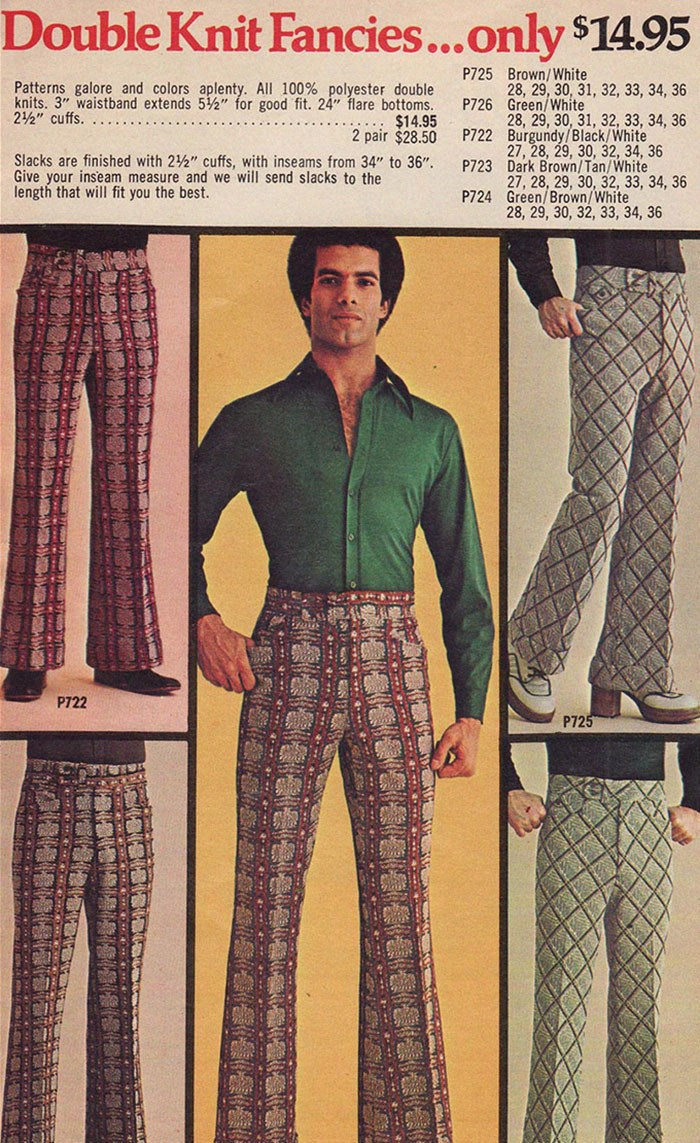
Double Knit Fancies… only $14.95. Cringeworthy men’s fashion trends from the 1970s. Image: Lifestyle.
.
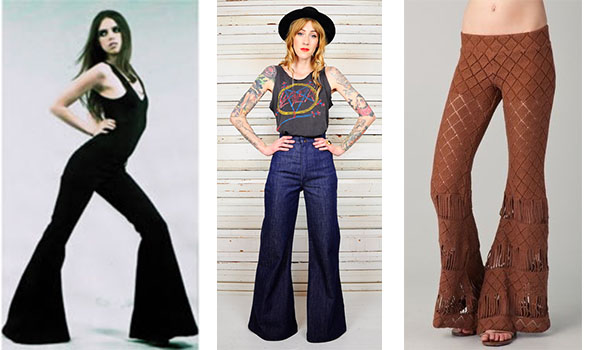
Cringeworthy Fashion Trends from the past: highwaisted (first 2 of 3 images) bellbottom pants. Destination Femme, February 23, 2018.
.
On Point. On Fleek. Stylin’. Dapper. Groovy.
.
“You know, my father used to say to me, ‘Nando, don’t be a schnook. It’s not how you feel, it’s how. You. Look!’ He was mahvelous! But you, dahling, hmmmm, you look mahvelous! Absolutely mahvelous! And this is from my tongue which is deep inside my body. It’s better to look good than to feel good.”
.
.
FASHIONABLE DESIGN
.
The history of fashion design refers to the development of the fashion industry which designs clothing and accessories. The modern industry, based around firms or fashion houses run by individual designers, started in the 19th century with Charles Frederick Worth who was the first designer to have his label sewn into the garments that he created.
.
.
ULTIMATELY, IT’S ALL ABOUT THE WAIST
.
To Victorians, on either side of the pond, ladies’ fashions were all about emphasizing the itty-bitty waistline. The snugger the corset, the bigger the sleeves, the tinier the waistline appears.
.

The vintage image (center) was published in The Washington Times of Washington, District of Columbia on March 24, 1895.
.
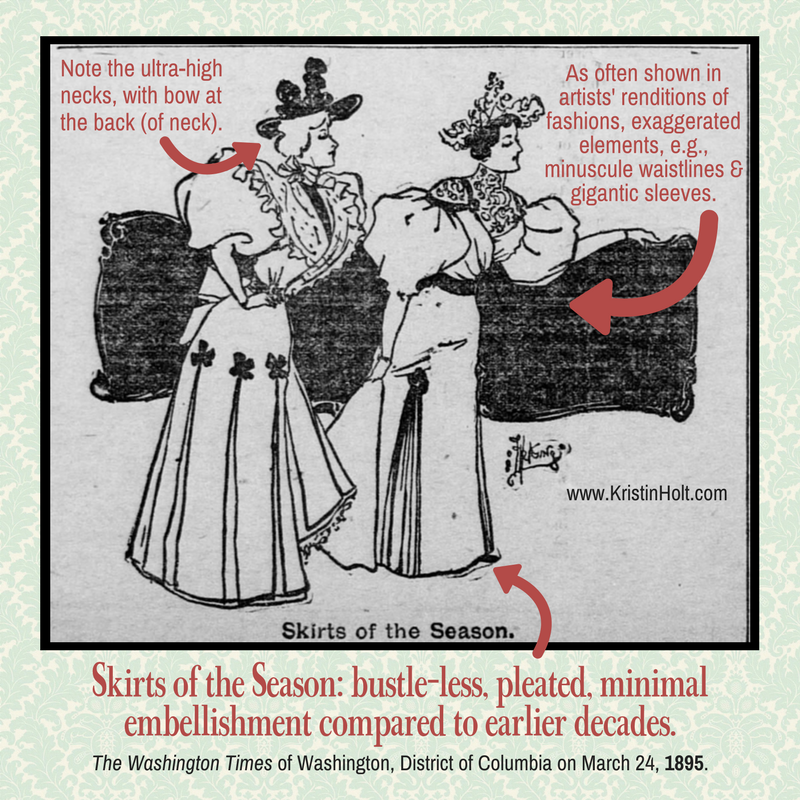
Itty Bitty Waists and Gigantic Sleeves… in advertising “Skirts of the Season”, in The Washington Times of Washington, District of Columbia on March 24, 1895.
.
HOW did those enormous sleeves hold their shape?
.
Sometimes, sleeve “enhancers” (sticky-outy-things) were sewn into the dress’s sleeves. Consider how boning can be sewn into a bodice’s seams, or how horsehair (it’s made of plastic now) can be sewn into the hem of certain fabrics to give the hem of the finished garment the body and shape desired.
Several examples of “sleeve supporters” (separate accoutrements, much like bustles, bust enhancers, or corsets) survived the lapse in time, and are on display in museums.
.

Sleeve Supporters, Assorted Styles. Provenance Unknown, via lilyabsinthe.com
.

Leg O Mutton Sleeve Supporter, credited to the Metropolitan Museum of Art, by Pinterest user.
.

1890s extant sleeve frame for leg of mutton sleeves, sold on ebay. Image pinned to a Pinterest board.
.
Notice the lightweight, cooler design of this last pair… wire loops held in place as affixed to ribbon (on top). The ribbon could be pinned or sewn into the costume’s bodice. Notice that the coils connected at the bottom may be simply bound with twine. Inventive Victorians!
.
HOW MUCH FABRIC DO THOSE SLEEVES REQUIRE?
.

Tailor Jacket with Five-part Sleeve, as shown in Harper’s Bazar (later, Harper’s Bazaar) in 1895. Images: Real Historical Patterns.
.

Harper’s Bazaar 1895: Cloth Costume with Velvet Garniture. Pattern Shapes show the many pieces that combine to style the Leg Of Mutton Sleeve. Image: Real Historical Patterns.
.
Note: “Costume” was the standard name for a woman’s ‘suit’ (skirt and jacket) until the late 1890s, when the term ‘suit’, as used with men’s “suit of clothes” began to be substituted for the women’s costume.
.

Leg of Mutton sleeve pattern piece, arranged on the fabric (folded with selvage edges together), among other bodice pieces. Image: The Pragmatic Costumer.
.
RE-CREATIONS of Huge Victorian Sleeves
.
YOU can wear them, too!
.
Note: See my “Where is She Now?” update post on Romancing the Genres, where I share many 19th century costumes I’ve sewn for myself:
.
.
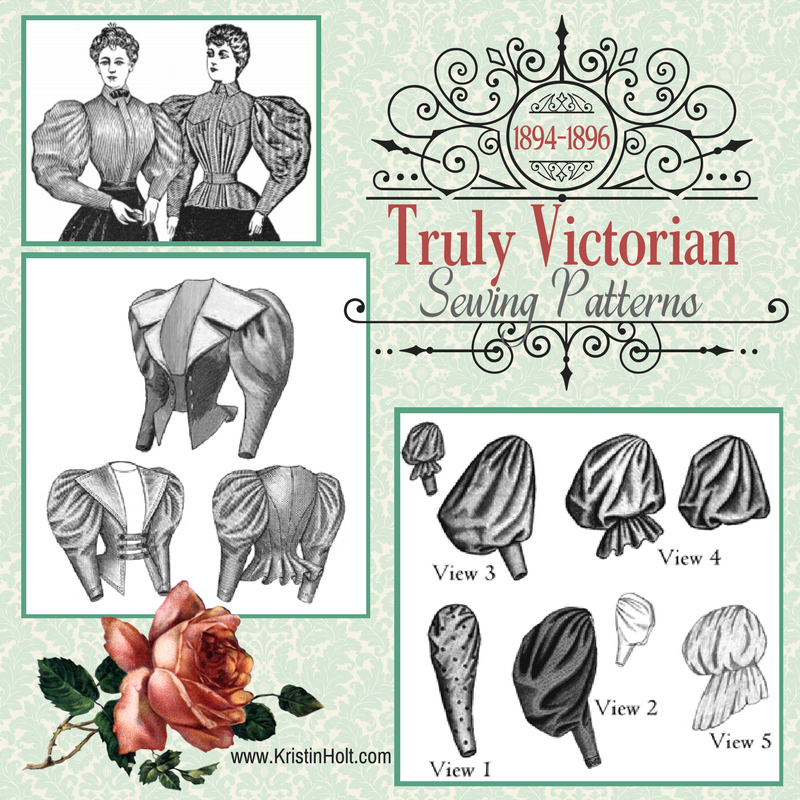
Sewing Patterns for shirtwaists, jackets, and sleeves (to add to any blouse, dress, or jacket) available from Truly Victorian.
.
Writing about the many sleeves option (lower right-hand corner) Truly Victorian- (TV495-1890’s Sleeves):
.
This pattern contains instructions for seven complete sleeves for the 1890’s era, four for day wear and three for evening. These sleeves will fit on any bodice or jacket with a high shoulder (not dropped).
.
View 1 is a moderate sized Leg-O’-Mutton sleeve. It is in two pieces with a full sleeve lining. It is suitable for use on a 1890-1897, daytime bodice or jacket.
.
View 2 is a two-piece Gigot sleeve. This is a very large sleeve, tight from elbow to wrist. It is suitable for 1894-1896, daytime bodice or jacket. This sleeve is a copy of an original pattern from Harper’s Bazar, 1895.
.
View 3 is a large pouf sleeve over fitted sleeve, suitable for a 1892-1897, daytime bodice. Can be made with or without the flair at the elbow.
.
View 4 is a large pouf evening sleeve. It has a fitted lining, and is suitable for 1892-1897 evening and ball gowns. Can be made with or without the flair at elbow. This sleeve is also appropriate for a young lady’s day bodice. This sleeve is a copy of an original pattern from Harper’s Bazar, 1895.
.
View 5 is a high pouf sleeve with wide flair over the elbow. Suitable for 1895-1897 evening bodices. Made out of a sheer fabric, it is especially elegant. This sleeve is as seen on the cover of an 1895 Harper’s Bazar issuem [sic]
.
Our Price (inc VAT): £18.50
.
.

“Circa 1895” gown, a sewing pattern from Simplicity (no. 4078).
.

1890s Waist (bodice) pattern, with Leg O Mutton sleeves, both long and short. From Laughing Moon, and for sale on Amazon.
.

1890s Victorian Waist Blouse with Leg of Mutton Sleeves, by Patterns of Time. Available at Amazon.
.

Five-gore skirt, 1890s Victorian Pattern in three lengths, by Patterns of Time. Bodice is likely made from the companion image, also from Patterns of Time. Available from Amazon.
.

“Making History” Sewing pattern from Butterick, No. 3716. Available at Amazon.
.

Ladies 1890s Victorian Sporting Costumes with Leggings (bloomers) Pattern from Laughing Moon Mercantile and Patterns of Time. Sold on Amazon.
.

“Circa 1895” Simplicity Sewing Pattern for a women’s costume (a.k.a. suit) at the height of fashion. Simplicity No. 4156. Available on Amazon, and also here (Amazon).
.
The designer of Simplicity pattern No. 4156 (shown in lime green and silver/white, immediately above), blogged about the design process, sewing this costume for her own use then selling the design to Simplicity… and her shock at discovering the pattern had been “borrowed” (a.k.a. “ripped off!”)… Stop by and read it!
As a home seamstress who’s never done a drop of design in my life, I found the images and the designer’s story fascinating (and stoked my ire as one who believes strongly in respecting intellectual property).
.
STYLES CHANGE (FINALLY!); SLEEVES NORMALIZE
.

The Fayette County Leader of Fayette, Iowa, on September 23, 1897, announced that “Big Sleeves [were] To Go”; as in on their way out of fashion.
.

On their way out of fashion quite yet–or not–The Chanute Times of Chanute, Kansas published this illustration on February 11, 1898.
.

Women’s Laundered Shirt Waist Blouses, probably 1900. For sale in Montgomery Ward Catalog.
.
Resources
.
.
RELATED ARTICLES
.
.
Updated December 2021
Copyright © 2018 Kristin Holt LC
Ladies Fashions: Huge Sleeves of the 1890s
Ladies Fashions: Huge Sleeves of the 1890s
Ladies Fashions: Huge Sleeves of the 1890s
























